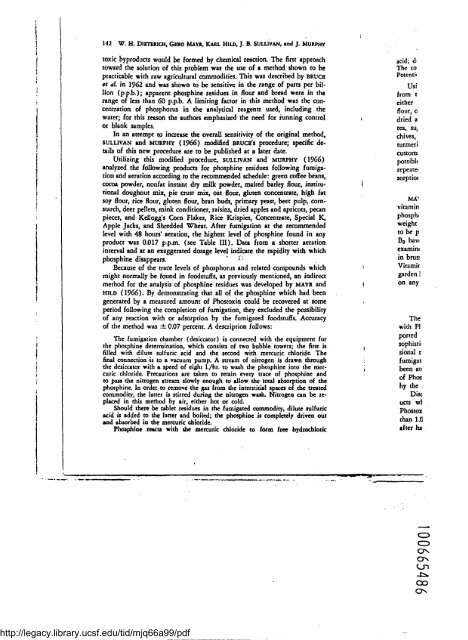Hydrogen phosphide as a fumigant for foods, feeds and processed ...
Hydrogen phosphide as a fumigant for foods, feeds and processed ...
Hydrogen phosphide as a fumigant for foods, feeds and processed ...
Create successful ePaper yourself
Turn your PDF publications into a flip-book with our unique Google optimized e-Paper software.
142 W. H. D1ErER1CH, GERO MAYR, KARL HILA, ) . B. SULLIVAN, <strong>and</strong> J . MURPHY<br />
toxic byproducts would be <strong>for</strong>med by chemical reaction . The first approach<br />
toward the solution of this problem w<strong>as</strong> the use of a method shown to be<br />
practicable with raw agricultural commodities. This w<strong>as</strong> described by BRUCE<br />
of al. in 1962 <strong>and</strong> w<strong>as</strong> shown to be sensitive in the range of parts per billion<br />
(p.p.b.) ; apparent phosphene residues in flour <strong>and</strong> bread were in the<br />
range of less than 60 p.p.b. A limiting factor in this method w<strong>as</strong> the concentration<br />
of phosphorus in the analytical reagents used, including the<br />
water; <strong>for</strong> this re<strong>as</strong>on the authors emph<strong>as</strong>ized the need <strong>for</strong> funning control<br />
or blank samples.<br />
In an attempt to incre<strong>as</strong>e the overall sensitivity of the original method,<br />
SULLIVAN <strong>and</strong> MURPHY (1966) modified BRUCE's procedure ; specific details<br />
of this new procedure are to be published at a later date .<br />
Utilizing this modified procedure, SULLIVAN <strong>and</strong> MURPHY (1966)<br />
analyzed the following products <strong>for</strong> phosphine residues following fumigation<br />
<strong>and</strong> aeration according to the recommended schedule : green coffee beans,<br />
cocoa powder, nonfat instant dry milk powder, malted barley flour, institu .<br />
tional doughnut mix, pie crust mix, oat flour, gluten concentrate, high fat<br />
soy flour, rice flour, gluten flour, bran buds, primary ye<strong>as</strong>t, beet pulp, cornstarch,<br />
deer pellets, mink conditioner, raisins, dried apples <strong>and</strong> apricots, pecan<br />
pieces, <strong>and</strong> Kellogg's Corn Flakes, Rice Krispies, Concentrate, Special K,<br />
Apple Jacks, <strong>and</strong> Shredded Wheat. After fumigation at the recommended<br />
level with 48 hours' aeration, the highest level of phosphine found in any<br />
product w<strong>as</strong> 0 .017 p .p.m. (see Table III) . Data from a shorter aeration<br />
interval <strong>and</strong> at an exaggerated dosage level indicate the rapidity with which<br />
phosphine disappears .<br />
Because of the trace levels of phosphorus <strong>and</strong> related compounds which<br />
might normally be found in <strong>foods</strong>tuffs, <strong>as</strong> previously mentioned, an indirect<br />
method <strong>for</strong> the analysis of phosphine residues w<strong>as</strong> developed by MAYR <strong>and</strong><br />
HILD (1966). By demonstrating that all of the phosphine which had been<br />
generated by a me<strong>as</strong>ured amount of Phostoxin could be recovered at some<br />
period following the completion of fumigation, they excluded the possibility<br />
of any reaction with or adsorption by the fumigated <strong>foods</strong>tuffs. Accuracy<br />
of the method w<strong>as</strong> ± 0.07 percent . A description follows :<br />
The fumigation chamber (desiccator) is connected with the equipment <strong>for</strong><br />
the phosphine determination, which consists of two bubble towers; the first is<br />
filled with dilute sulfuric acid <strong>and</strong> the second with mercuric chloride . The<br />
final connection is to a vacuum pump. A stream of nitrogen is drawn through<br />
the desiccator with a speed of eight 1./fir. to w<strong>as</strong>h the phosphine into the mercuric<br />
chloride. Precautions are taken to retain every trace of phosphine <strong>and</strong><br />
to p<strong>as</strong>s the nitrogen stream slowly enough to allow the total absorption of the<br />
phosphine. In order to remove the g<strong>as</strong> from the interstitial spaces of the treated<br />
commodity, the latter is stirred during the nitrogen w<strong>as</strong>h . Nitrogen can be replaced<br />
in this method by air, either hot or cold .<br />
Should there be tablet residues in the fumigated commodity, dilute sulfuric<br />
acid is added to the latter <strong>and</strong> boiled; the phosphine is completely driven out<br />
<strong>and</strong> absorbed in the mercuric chloride .<br />
Phosphine reacts with the mercuric chloride to <strong>for</strong>m free hydrochloric<br />
M<br />
1<br />
i<br />
acid ; d-<br />
The co<br />
Potenti'<br />
Usi<br />
from t<br />
either<br />
flour, o<br />
dried a<br />
tea, su;<br />
chives,<br />
turmeri<br />
custom:<br />
possibh<br />
repeate,<br />
sorptio t<br />
MA'<br />
vitamin<br />
phosphi<br />
weight<br />
to be p<br />
Ba. haw<br />
examint<br />
in br<strong>as</strong>:<br />
Vitamit<br />
garden I<br />
on any<br />
The<br />
with P1<br />
ported<br />
sophisti,<br />
sional r<br />
fumigat<br />
been at'<br />
of Phos<br />
by the<br />
Disc<br />
ucts wl<br />
Phostox<br />
than 1 .0<br />
after ha<br />
http://legacy.library.ucsf.edu/tid/mjq66a99/pdf
















